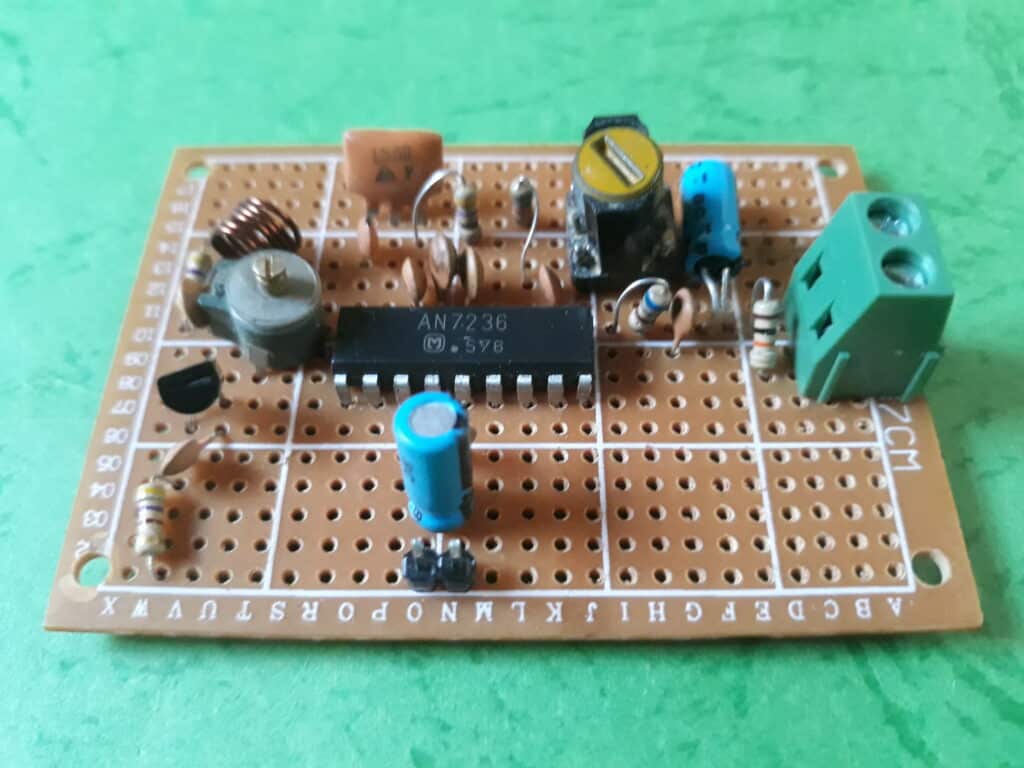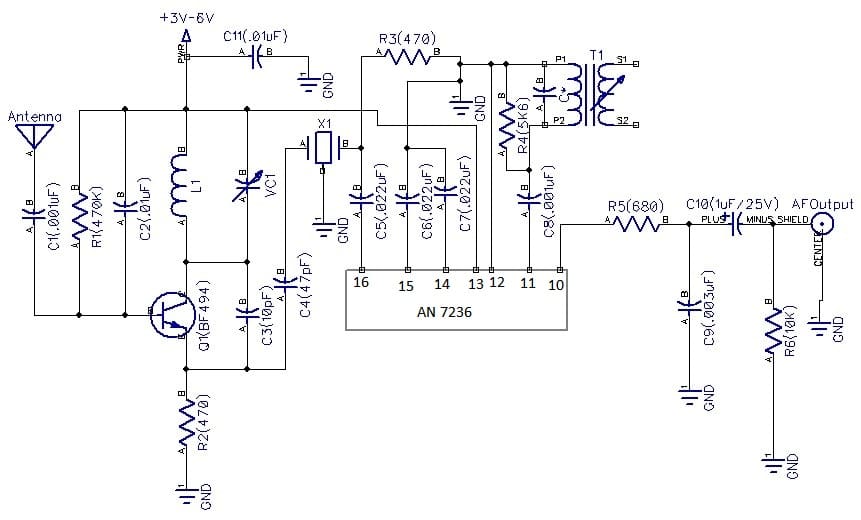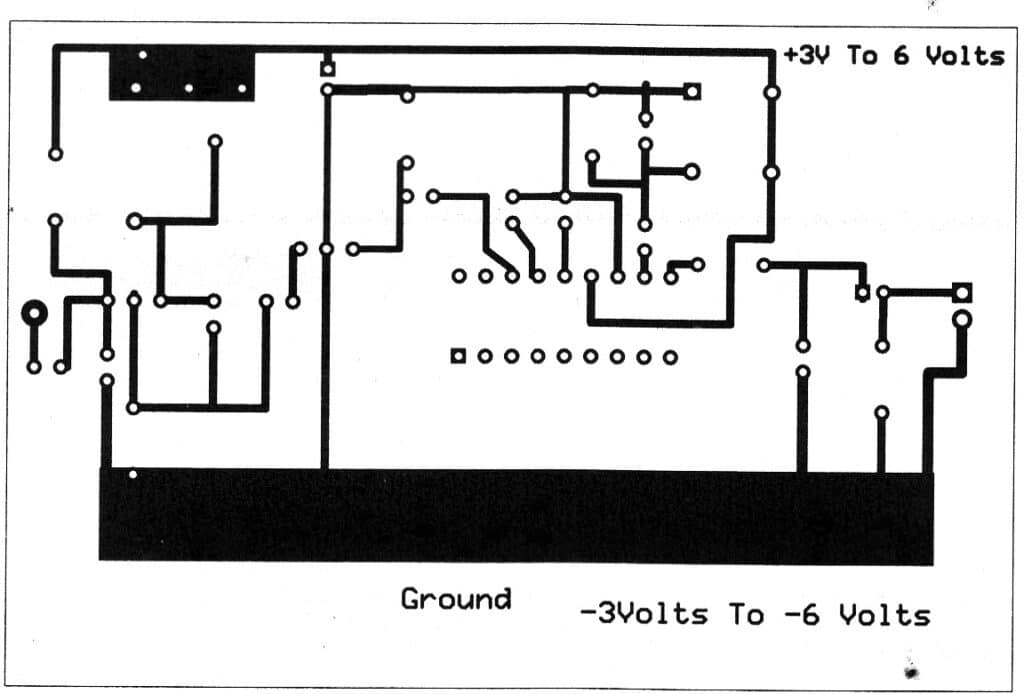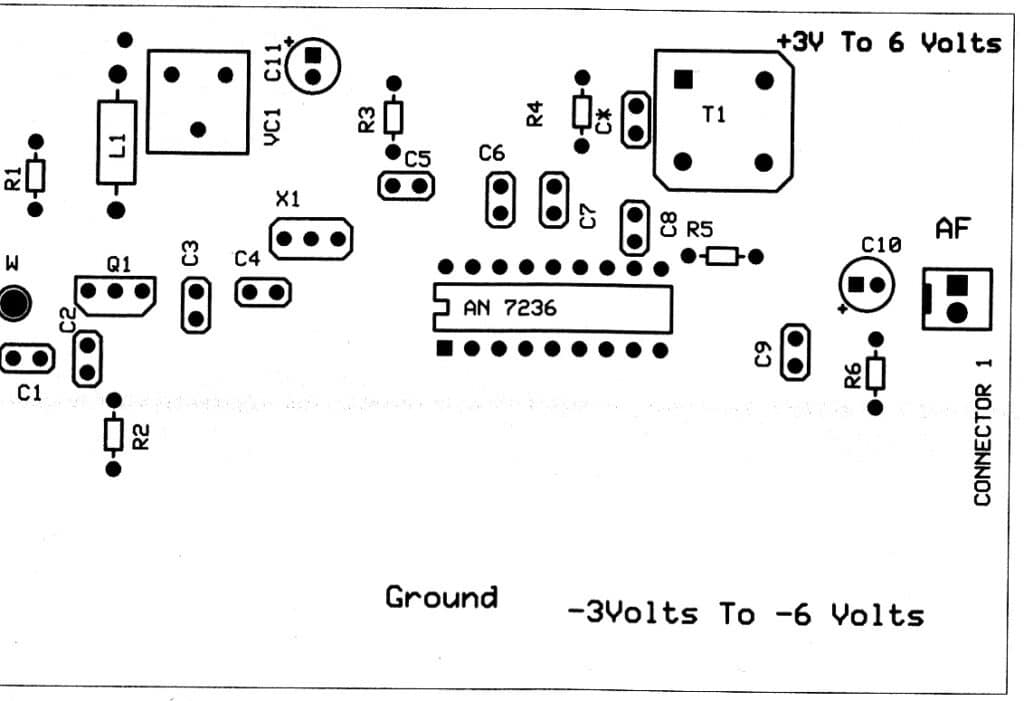
This is a simple FM Radio Receiver that is built around a single IC1 AN7236 (18-pin), a single HF transistor Q1( BF 494) and a few external components.
This FM radio can be tuned for frequencies between 88.00MHz and 108.00MHz. IC1 AN7236 is an 18-pin IC, and this IC and other components used in this FM radio can be purchased easily in the market.

Parts List
| Semiconductor | Q1: BF 494, IC1: AN 7236 |
| Resistors | R1: 470K |
| R2, R3: 470 | |
| R4: 5K6 | |
| R5: 680 | |
| R6:10K | |
| One 18-pin IC socket | C1:0.001uF |
| C2, C11: .01uF | |
| C3: 10pF | |
| C4:47pF | |
| C5, C6 and C7:022uF | |
| C8:.001uF | |
| C9:.003uF | |
| C10: 1uF/25V | |
| X1: 3-pins 5.5MHz ceramic filter | |
| Miscellaneous | One 18-pin IC socket |
| One 2-pin connector | |
| 75 cm long wire, vero board size 5cm*7cm, 3 V-6 V battery, 23 SWG copper wire, VC1: 2-22pF trimmer capacitor |
Circuit and Working
The circuit is very simple and straightforward. The heart of this circuit is a single IC1 AN7236. The circuit is divided into 2 parts. The first part is an RF section and the second part is a 5.5 MHz IF section. An HF transistor Q1 BF 494 was used in the first part, and IC1 AN 7236 was used in the second part.

A transistor Q1 BF494, VC1 (2-22pF Trimmer Capacitor), ceramic capacitors C1, C2, C3, resistors (R1 and R2) and an inductor coil L1 (5 turns of 23 SWG wire 5mm air core) will work as an RF oscillator frequency between 93.5 MHz-113.5 MHz. Resistor R1 (470K) is connected between +3V to +6Volts and a base of Q1 BF 494.
Resistor R2 (470) is connected between the emitter and the ground. Inductor L1 and a trimmer capacitor VR1 are connected in parallel to each other and to a supply +3V to +6V and a collector of Q1 (BF494).
Capacitor C2 is connected to supply +3 to +6 Volts and a base of Q1(BF494). A feedback capacitor C3 was connected between the collector and emitter of Q1 BF 494. Trimmer capacitor VC1 works as tuning between frequencies between 88.00MHz to 108.00MHz.
An antenna of 75cm will receive the frequencies between 88.00MHz-108.00MHz. These frequencies are mixed with the frequencies 93.5 MHz-113.5 MHz generated by oscillator frequencies comprising HF transistors Q1 BF494 and other components.
An IF frequency of 5.5MHz generated after mixing is taken away from an emitter of Q1 BF494 to an input of a 5.5 MHz ceramic filter through a ceramic capacitor C4 (47pF).
An IF frequency of 5.5MHz taken away from C4 is passed to an input of 5.5MHz ceramic filter and is passed to pin 16 of IC1 AN7236 through a capacitor C5 (.022uF). A resistor R3 (470) was connected between pin-3 of X1 5.5MHz ceramic filter and ground.
Pin 12 is connected to the ground. Pin 14 and 15 of AN 7236 are connected to the ground with a capacitor C6, C7 (.022uF). Pin 13 is connected to +3 Volts to +6 Volts.
A capacitor C11 (.01uF) and an electrolytic capacitor C12 (100uF/25V) were connected between +3V and ground and will filter a DC voltage. Pin 11 is connected to a T1 5.5 MHz IFT coil with a ceramic capacitor C8 and other terminals of T1 to the ground.
A resistor R4 (5K6) is connected with parallel to T1 and ground. An audio output is taken away from a pin 10 through a resistor R5 (680) in series with an electrolytic capacitor C10 (1uF/25V) and to a 2-pin output connector.
A resistor R6 (10K) is connected between a negative terminal of C10 (1uF/25V) and ground. A capacitor C9 (.003uF) is connected between a positive terminal of C10 (1uF/25V) and to a ground which will filter an AF output signal.
Construction and Testing
A vero-board of size 5cm*7cm is suitable for making your FM radio. You may also build your own PCB whose PCB pattern was given in an article. At first, take an 18-pin IC socket and place it on the middle part of a veroboard (5cm*7cm).
Place a 2-pin connector on the right side of a veroboard. Now place all the remaining components like Q1 (BF494), VC1(2-22pF trimmer capacitor), 5.5 MHz ceramic filter, 5.5 MHz IFT coil, resistors and ceramic capacitors etc. as shown in a circuit diagram.

Now take a 15-watt soldering iron and solder all the components. Do not insert an IC during soldering, otherwise, it will damage an IC1.
Next, we will make an inductor L1. For this, you will need a piece of 23 SWG wire. Now wind a 5-turn of 23 SWG wire on a 5 mm diameter of air core.
Connect a piece of wire of 75cm long wire to the base of a transistor Q1 BF 494 through a capacitor C1 (.001uF) if you are getting a low signal.

Now we will test a circuit. Take any AF amplifier and connect it to an AF output terminal of your FM radio. Take a plastic screwdriver and gently tune a VC1 (Tuning capacitor) until you hear stations. Now tune a 5.5 MHz IFT core gently until you hear a clear audio output sound. Now your FM radio receiver is working and ready for listening*
Note: In this AN7236 FM radio we are using a 5.5MHz IF frequency in the state of 10.7MHz IF frequency because 5.5MHz IFT coil (T1) and 5.5MHz ceramic can be easily found easily in a market and can be taken off from your old Black and White TV sets and from other things.
Also Check Other FM Radio Receiver Projects and Circuits







